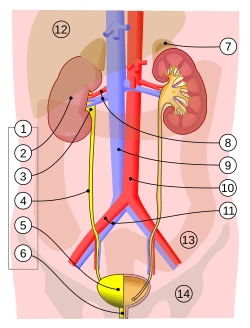Bladder facts for kids
Quick facts for kids Urinary bladder |
|
|---|---|
 |
|
| 1. Human urinary system: 2. Kidney, 3. Renal pelvis, 4. Ureter, 5. Urinary bladder, 6. Urethra. (Left side with frontal section) 7. Adrenal gland Vessels: 8. Renal artery and vein, 9. Inferior vena cava, 10. Abdominal aorta, 11. Common iliac artery and vein With transparency: 12. Liver, 13. Large intestine, 14. Pelvis |
|
| Latin | vesica urinaria |
| System | Urinary system |
| Precursor | urogenital sinus |
The urinary bladder, or simply bladder, is a hollow organ in humans and other vertebrates that stores urine from the kidneys before disposal by urination. The typical adult human bladder will hold between 300 and 500 ml (10.14 and 16.91 fl oz) before the urge to empty occurs, but can hold considerably more.
Function
Urine, excreted by the kidneys, collects in the bladder before disposal by urination (micturition). Urine leaves the bladder via the urethra, a single muscular tube ending in an opening called the urinary meatus, where it exits the body.
Urination involves coordinated muscle changes involving a reflex based in the spine, with higher inputs from the brain. During urination, the detrusor muscle contracts, allowing urine to pass through the urethra and out of the body.
The urge to pass urine stems from stretch receptors that activate when between 300 - 400 mL urine is held within the bladder. Urination is controlled by the pontine micturition center in the brainstem.
Other animals
Mammals
All mammals have a urinary bladder. The urinary bladder of the cetaceans (whales and dolphins) is proportionally smaller than that of land-dwelling mammals.
Reptiles
In all reptiles, the urinogenital ducts and the anus both empty into an organ called a cloaca. It is present in all turtles and tortoises as well as most lizards but is lacking in the monitor lizard, the legless lizards. It is absent in the snakes, alligators, and crocodiles.
Many turtles, tortoises, and lizards have proportionally very large bladders. Charles Darwin noted that the Galapagos tortoise had a bladder which could store up to 20% of its body weight. Such adaptations are the result of environments such as remote islands and deserts where water is very scarce. Other desert-dwelling reptiles have large bladders that can store a long-term reservoir of water for up to several months and aid in osmoregulation.
Turtles have two or more accessory urinary bladders, located lateral to the neck of the urinary bladder and dorsal to the pubis, occupying a significant portion of their body cavity. Their bladder usually has a left and right section. The right section is located under the liver, which prevents large stones from remaining in that side while the left section is more likely to have calculi.
Amphibians
Most aquatic and semi-aquatic amphibians have a membranous skin which allows them to absorb water directly through it. The urinary bladder assists such animals to retain salts. For land-dwelling amphibians, dehydration results in reduced urine output.
The amphibian bladder is usually highly distensible and among some land-dwelling species of frogs and salamanders may account for between 20% and 50% of their total body weight.
Fish
The gills of most teleost fish help to eliminate ammonia from the body, and fish live surrounded by water, but most still have a distinct bladder for storing waste fluid. Most fish also have an organ called a swim-bladder which is unrelated to the urinary bladder except in its membranous nature. The loaches, pilchards, and herrings are among the few types of fish in which a urinary bladder is poorly developed.
Birds
In nearly all bird species, there is no urinary bladder per se. Although all birds have kidneys, the ureters open directly into a cloaca which serves as a reservoir for urine, fecal matter, and eggs.
Crustaceans
Unlike the urinary bladder of vertebrates, the urinary bladder of crustaceans both stores and modifies urine. The bladder consists of two sets of lateral and central lobes. The central lobes sit near the digestive organs and the lateral lobes extend along the front and sides of the crustacean's body cavity. The tissue of the bladder is thin epithelium.
See also
 In Spanish: Vejiga urinaria para niños
In Spanish: Vejiga urinaria para niños

